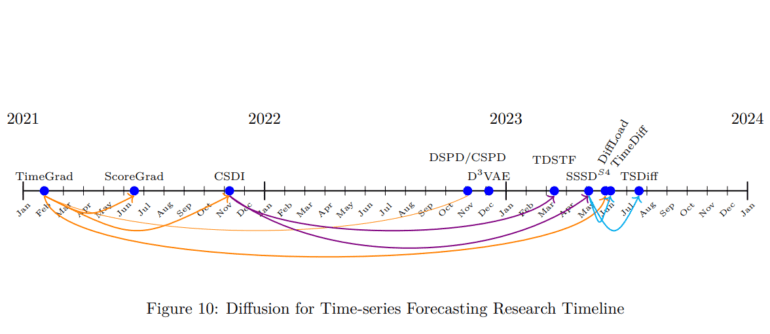TL;DR:
- Generative AI powered by deep learning is revolutionizing diverse sectors, from education and healthcare to the corporate world.
- Deep learning’s ability to discern intricate patterns and generate data samples has been pivotal in this transformation.
- Time-series forecasting, crucial for predicting future events using historical data, poses unique challenges due to complex relationships and temporal dependencies.
- A recent study from Delft University explores the integration of diffusion models into time-series forecasting, yielding groundbreaking outcomes.
- The research covers 11 distinct time-series diffusion model implementations, analyzing their theoretical foundations, efficiency, and comparative advantages.
- The study offers insights into how diffusion models can enhance time-series forecasting, presenting a chronological overview of their evolution.
- The researchers share key contributions, including an exploration of diffusion models, their chronological presentation, practical analysis, and comparative assessment.
Main AI News:
In the realm of artificial intelligence (AI), the transformative power of generative AI, driven by deep learning, has made significant inroads across diverse sectors, spanning education, healthcare, and the corporate landscape. Deep learning, as the cornerstone, equips AI with the remarkable capability to discern intricate patterns within data and generate intricate data samples that faithfully capture the statistical attributes of a given dataset.
One crucial facet of AI’s evolution lies in the emergence of generative AI, which possesses the capacity to produce distinctive and innovative data samples that faithfully mirror the statistical characteristics of a designated dataset. This development holds profound implications for the field of time-series forecasting, a domain of paramount importance for foreseeing future events by leveraging historical data. The unique challenges and opportunities presented by time-series data, marked by intricate relationships and temporal dependencies, have a profound impact on sectors such as energy management, traffic control, and healthcare prediction.
In a recent comprehensive investigation conducted by a dedicated team of researchers hailing from Delft University of Technology, the integration of diffusion models into the realm of time-series forecasting took center stage. This pioneering study has yielded state-of-the-art outcomes across various generative AI domains, significantly enriching our understanding of the potential applications of diffusion models. The researchers embarked on a meticulous exploration, delving into the intricacies of diffusion models and scrutinizing their conditioning techniques. Furthermore, they conducted a thorough assessment of the model’s efficacy in the context of time-series forecasting.
This groundbreaking research has encompassed a total of eleven distinct implementations of time-series diffusion models, each subjected to rigorous scrutiny in terms of their theoretical foundations and underlying principles. The research also examined their practical effectiveness and efficiency across a diverse array of datasets. In addition, the study has furnished a comprehensive comparative analysis of these eleven implementations, shedding light on their individual strengths and weaknesses.
Notably, this research has made a substantial contribution by elucidating the potential applications of diffusion models in the realm of time-series forecasting. Beyond a mere listing of models, the study provides an insightful chronological overview, facilitating a nuanced understanding of how these models have evolved over time. The research team has generously shared their key contributions, encapsulated in the following highlights:
- An expansive introductory section that offers an in-depth exploration of diffusion models, alongside an examination of the conditioning techniques pertinent to time-series modeling.
- A chronological presentation of diffusion models, specially tailored for time-series forecasting, going beyond a mere enumeration. This section provides a detailed exploration of their implementation, outcomes across diverse datasets, and a comprehensive comparative discussion vis-à-vis other diffusion models.
- A meticulous analysis that provides valuable insights into the practical utilization of diffusion models, offering a sophisticated understanding of their functioning within the framework of time-series forecasting.
- Detailed documentation of the performance outcomes of diffusion models across multiple datasets, fostering a practical understanding of their adaptability across various contexts.
- Inclusion of a comparative analysis that juxtaposes the highlighted diffusion models with others, facilitating a contextualized assessment of each model’s strengths and weaknesses for the benefit of researchers and practitioners alike.
Conclusion:
The integration of diffusion models into time-series forecasting represents a significant advancement in AI applications. This innovation holds promise for improving predictive accuracy across various industries, such as energy management, traffic control, and healthcare. Businesses that embrace these advancements in AI technology can gain a competitive edge by making more informed decisions and optimizing their operations.

